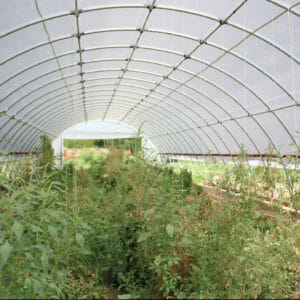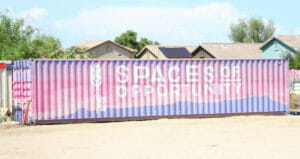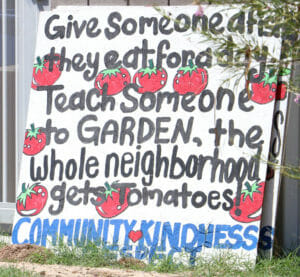
Located in South Phoenix at the northeast corner of Vineyard Road and 15th avenue is the Spaces of Opportunity Garden. The garden is a collaboration between four different nonprofit groups with the goal of transforming empty lots into a diverse agricultural and educational asset in the community. The four nonprofits involved are the Desert Botanical Garden, Unlimited Potential, TigerMountain Foundation, and Orchard Community Learning Center. Recently, John Wann–Ángeles, the director of the Orchard Community Learning Center, took some time to show us the urban agriculture collaboration.
Started in 2018, Spaces of Opportunity Garden is a partnership with the community that provides education and nourishment simultaneously. Along the east wall of the roughly 19-acre space is a mural that depicts the rich history of agriculture in the valley. The mural starts with the Hohokam civilization illustrating their agricultural practices and traditions, including the creation of canal systems. The mural continues through time telling the story of all nations that have called this valley home, finishing with the current state of food culture in what is now modern-day Phoenix. By looking back at the history of the valley, the Spaces of Opportunity Garden sets the stage for what can be learned, and perhaps what can be reimagined.

The entry of the garden is an open courtyard covered by shade structures which acts as a communal space, and is the location of their farmers market every Saturday. The farmers market features products from the garden as well as other producers from South Phoenix. At the other end of the garden is a wash, pack, and storage facility constructed out of an old shipping container, creating a nature exploratory classroom. This classroom is an interactive learning space with features that can be pieced together and moved so that the playground or classroom is interchangeable and exciting. Educating the next generation is an extremely important part of the mission of the garden. They have partnered with an elementary school across the street in the Roosevelt school district to put together a culinary and sustainability program with the intention of educating young students about the importance of sustainability and food and how the two are intertwined.
Following the main path northeast underneath a canopy of trees, we arrive at the cactus garden. In this garden, cacti are used to teach visitors about the fruits that can be harvested and the traditions that are connected to those harvests. It also challenges the language commonly used in food systems work: “food desert”. A food desert, as defined by the USDA, is an area with limited or no access to affordable fresh and healthy foods. A term that more accurately depicts what is happening in these communities is “food apartheid”. In a 2018 interview with the magazine Guernica, food activist Karen Washington articulates these differences. The term “food desert” carries with it the implications that the area is desolate and lifeless. This is far from the truth as communities that fall under this definition are “vibrant and full of potential”. Food apartheid acknowledges the socio-economic challenges that have influenced food systems, often withholding resources that can help bring about true change by bringing decision making into the fabric of the community. While falling short of describing neighborhoods and communities, it also leaves a negative impression on the ecosystems. Deserts are extremely biodiverse and full of life; you just need to know where to look. Humans have been able to inhabit the southwest for thousands of years despite it being one of the most arid climates in the world. The cactus garden educates the community on these issues emphasizing the importance of language.
As the main path turns west, away from the Cactus Garden, we walk past a section of garden plots that can be rented by community members for $5 a month. Participants have access to water and land to grow what they want or need. Beyond the community garden is a high tunnel which is used to regulate temperatures, keeping the inside slightly cooler in the summertime and slightly warmer in the wintertime which allows for vegetable production all twelve months of the year. Temperature regulation is important for farms in South Phoenix, John informed us, because as winds blow air down from South Mountain the temperatures are significantly cooler in comparison to central Phoenix, resulting in more nights that drop below freezing compared to the rest of the valley.

Two other projects that John spoke to us about were the food forest, launching next spring, and the composting project which is located at a different location. The food forest is in partnership with ASU and will be designed to provide the community with more diverse availability of fruits and vegetables. The food forest is also a project that looks to reimagine how public spaces can be used, combining recreation with food production. The composting project works with nearby restaurants to collect food scraps, diverting those scraps from the landfill to a composting facility. The finished compost is then used by the garden and is also available to members of the community for purchase. The composting project is a model that could be used by municipalities throughout the valley to reduce food waste and turn a product headed for the landfill into a valuable resource that can be used in future food production.
The Spaces of Opportunity Garden is still growing and evolving as the different organizations work to build the infrastructure for projects that they have each decided to tackle, but there is clear intention throughout the project that combines education and practicality. They have built a model that demonstrates how communities can be reconnected to the food system, empowering them to decide how their food is produced. This model can be used to bridge the disconnect that exists between communities and our food systems.